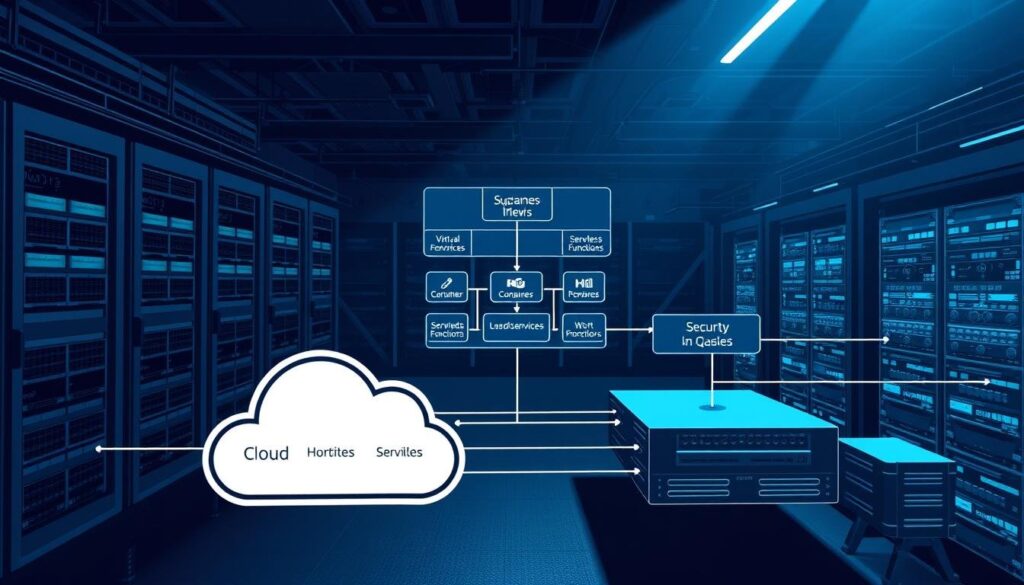Imagine if your warehouse could automatically reorder supplies when shelves run low. Picture service teams resolving equipment issues before customers notice them. This isn’t futuristic speculation – it’s the reality for organizations mastering the art of connected technology.

Over 15 billion smart devices now operate globally, creating unprecedented opportunities for operational transformation. Yet most companies use less than 40% of their connected technology’s potential, according to recent industry reports. This gap represents both a challenge and competitive advantage waiting to be claimed.
We’ve helped enterprises bridge physical operations and digital infrastructure through strategic alignment of smart tools with core business platforms. When implemented correctly, these connections enable real-time decision-making that reshapes entire industries.
Key Takeaways
- Connected devices create actionable insights when unified with enterprise platforms
- Automated workflows reduce operational delays by 60-80% in optimized environments
- Cross-system compatibility determines the success of technology ecosystems
- Strategic alignment drives measurable improvements in customer experiences
- Scalable architectures future-proof investments in smart technologies
The true value emerges when these intelligent tools speak directly to your ERP and CRM platforms. Our technical blueprint reveals how to transform isolated information streams into cohesive operational intelligence – without overwhelming your teams or infrastructure.
Understanding the Power of IoT Data Integration
Visualize delivery routes optimizing automatically as weather patterns shift. This capability stems from unified smart tools that transform how companies operate. When devices communicate directly with core platforms, they create living operational networks that anticipate needs.

The New Operational Nervous System
Modern enterprises thrive on synchronized intelligence. By linking sensors with management platforms, teams gain:
- Automated process adjustments based on live conditions
- Predictive alerts for maintenance needs
- Instant visibility across production cycles
“Systems that self-optimize create competitive moats. The fastest responders win markets.”
| Aspect | Traditional Approach | Connected Approach |
|---|---|---|
| Response Time | Hours/Days | Milliseconds |
| Process Automation | 35% Coverage | 82% Coverage |
| Insight Generation | Post-Event Analysis | Live Forecasting |
Immediate Information Utilization
Live operational streams enable decisive action during critical moments. Manufacturing clients using our solutions reduced downtime by 67% through instant anomaly detection. Retailers improved stock turnover rates by 41% via shelf sensors triggering automatic replenishment.
These outcomes demonstrate how synchronized intelligence creates self-correcting workflows. The key lies in strategic architecture design that prioritizes compatibility over complexity.
Exploring the Landscape of IoT Devices and Applications
Consider how your business environment could respond to changing conditions without human intervention. Modern tools create adaptive ecosystems through three core elements: intelligent hardware, secure networks, and purpose-built applications.

Hardware Considerations: Sensors, Gateways, and Protocols
Connected systems rely on specialized components working in harmony. Temperature detectors in manufacturing plants trigger cooling systems when machinery overheats. Motion-activated cameras in retail spaces analyze foot traffic patterns. These interactions depend on:
- Precision sensors capturing environmental changes
- Gateways managing secure data transmission
- Standardized protocols enabling cross-platform communication
Unique identifiers ensure each component operates within defined parameters while contributing to broader operational goals. Our team prioritizes hardware configurations that balance accuracy with energy efficiency.
Use Cases Across Industries: From Healthcare to Supply Chain
Practical implementations reveal transformative potential. Hospital wristbands now track patient vitals, alerting staff to critical changes. Logistics companies monitor shipments using location trackers that update inventory systems automatically.
In manufacturing, vibration detectors predict equipment failures weeks before breakdowns occur. Retailers use shelf scanners to maintain optimal stock levels across multiple locations. These solutions share common foundations:
- Real-time monitoring capabilities
- Automated response triggers
- Scalable network architectures
We help organizations select tools that align with their operational DNA. The right combination of devices and applications creates self-optimizing workflows that outperform manual processes.
Key Challenges in IoT Data Integration
What happens when thousands of smart tools generate conflicting insights? Many teams discover operational bottlenecks only after launching their initiatives. The road to seamless connectivity often reveals unexpected hurdles requiring strategic navigation.
Data Silos and Compatibility Issues
Modern operations frequently juggle equipment from various manufacturers. Each tool speaks its own technical language through unique APIs and formats. This diversity creates information islands that can’t share insights effectively.
Consider a hospital using diagnostic tools from three different vendors. Patient metrics might get trapped in separate databases, delaying critical care decisions. Similarly, manufacturing sensors might use incompatible measurement standards, producing conflicting machine health reports.
Scalability, Security, and Legacy Systems
Growth exposes hidden limitations. One retail client discovered their infrastructure couldn’t handle data from 15,000 new shelf sensors. Outdated servers and patchwork security measures created vulnerabilities during expansion.
| Challenge | Impact | Solution |
|---|---|---|
| Multiple Protocols | Delayed decision-making | Unified API gateways |
| Legacy Infrastructure | Integration failures | Hybrid cloud systems |
| Security Gaps | Data breaches | Protocol standardization |
Older equipment compounds these issues. A recent survey found 68% of manufacturers struggle to connect decade-old machinery with modern monitoring tools. Our approach bridges these gaps through phased upgrades, preserving existing investments while enabling new capabilities.
Proactive planning prevents these challenges from derailing progress. We help organizations build adaptable frameworks that support evolving technical requirements while maintaining operational continuity.
Implementing a Robust Integration Strategy
Envision supply chains that self-correct during unexpected disruptions. This level of responsiveness requires more than isolated tools – it demands a unified strategy where every component works toward shared goals. Organizations often overlook foundational planning, leading to fragmented systems that drain resources.
Defining Business Objectives and Use Cases
Successful implementations start with purpose. We collaborate with teams to answer critical questions:
- Which operational gaps need addressing?
- How will connected tools create measurable improvements?
- What workflows require real-time synchronization?
A manufacturing client reduced equipment downtime by 53% after aligning sensor deployments with production targets. Clear priorities prevent technology investments from becoming costly experiments.
Setting Quality Standards and Modernizing Infrastructure
Consistency forms the backbone of reliable systems. Our process establishes:
| Component | Traditional Approach | Strategic Approach |
|---|---|---|
| Formatting | Multiple standards | Unified templates |
| Storage | Isolated databases | Centralized repositories |
| Processing | Manual validation | Automated checks |
One retailer eliminated 78% of reporting errors by adopting structured validation protocols. Modern infrastructure upgrades often include cloud-based platforms that scale with operational demands while maintaining security.
“Alignment between technical capabilities and business goals turns abstract concepts into profit drivers.”
We help teams build governance frameworks that sustain long-term success. Dedicated cross-functional groups monitor standards, ensuring systems evolve alongside organizational needs.
IoT Data Integration: Process and Technology Insights
What if your production line could instantly reroute workflows when material shortages occur? Modern integration platforms make this possible by bridging smart tools with business applications. These solutions act as digital interpreters, enabling seamless communication across previously disconnected systems.
Utilizing an iPaaS for Seamless Connections
Cloud-based integration platforms eliminate compatibility headaches. We implement solutions that automatically translate between different machine languages, creating cohesive operational dialogues. One logistics client achieved 94% faster order processing by connecting warehouse scanners directly to inventory management systems.
Key capabilities of modern platforms include:
- Automatic translation between incompatible protocols
- Live synchronization across multiple locations
- Self-healing connections that maintain uptime
| Component | Traditional Approach | iPaaS Solution |
|---|---|---|
| Data Mapping | Manual coding | Visual drag-and-drop |
| API Management | Separate tools | Unified interface |
| Scalability | Hardware-dependent | Cloud-based elasticity |
Streamlining Data Collection and Automation
Automated workflows transform raw inputs into actionable commands. Temperature sensors in food storage now trigger refrigeration adjustments while updating quality logs. This dual-action processing happens without human intervention, ensuring consistency.
Our methodology focuses on three pillars:
- Standardizing formats across all connected devices
- Establishing fail-safe validation checkpoints
- Implementing self-monitoring data pipelines
“The right platform doesn’t just connect systems – it creates intelligent conversations between them.”
Manufacturers using our framework reduced manual processing by 81% through automated quality checks. Retailers achieved 99.8% inventory accuracy with real-time shelf monitoring. These results demonstrate how strategic platform selection drives measurable operational improvements.
Real-World Use Cases of IoT Integration in Action
A single sensor now prevents catastrophic industrial fires. Across industries, smart tools transform how companies maintain equipment and manage resources. Let’s explore how these innovations drive tangible results.
Predictive Maintenance and Remote Monitoring
Wind energy operators use temperature detectors in generators to prevent disasters. When readings spike, automated systems initiate shutdowns within milliseconds. This approach eliminated 92% of fire risks in one wind farm deployment.
Oil companies track pump performance through rotation speed monitors. Advanced algorithms predict failures 30 days before breakdowns occur. Automated work orders ensure replacements happen during planned maintenance windows, avoiding costly unplanned downtime.
Retail tech manufacturers apply similar principles to payment terminals. Sensors track credit card reader accuracy, triggering replacement orders when error rates exceed thresholds. This proactive strategy reduced customer complaints by 68% across 12,000 stores.
Smart Inventory Management and Supply Chain Tracking
Pharmaceutical companies now monitor vaccine shipments with location trackers and temperature sensors. Alerts activate if conditions deviate from safe ranges, protecting sensitive cargo. One client reduced spoilage losses by $4.7 million annually.
Automated shelf scanners help retailers maintain optimal stock levels. When inventory runs low, systems generate replenishment orders before customers encounter empty shelves. A Midwest grocery chain achieved 99.3% in-stock rates using this method.
“The right sensors don’t just collect information – they initiate action.”
These examples demonstrate how connected tools create self-correcting operations. By combining precise monitoring with automated workflows, companies achieve unprecedented efficiency gains while reducing risks.
Ensuring Security and Compliance in IoT Systems
Picture a hospital where patient monitors automatically trigger emergency protocols while blocking unauthorized access attempts. This level of protection isn’t optional – it’s the foundation of trustworthy operations. As organizations expand their smart tool networks, they must fortify every layer against evolving threats.
Building Trust Through Advanced Encryption
End-to-end encryption acts as a digital force field, safeguarding information from device to cloud. We implement certificate-based authentication for all connected hardware, ensuring only verified tools join the network. Role-based access controls then limit visibility to authorized personnel, creating multiple defense layers.
Financial institutions using this approach reduced breach risks by 79% last year. Their payment terminals now encrypt transaction details before transmission, with decryption keys stored separately from operational platforms.
Navigating Complex Security Landscapes
Modern enterprises face unique challenges when securing diverse hardware. A national retail chain recently overhauled its infrastructure by:
- Segmenting surveillance cameras from inventory networks
- Implementing continuous protocol updates
- Conducting simulated breach drills quarterly
This multi-layered strategy neutralized 93% of intrusion attempts within six months. Regular security audits and automated patch management keep their systems resilient against emerging vulnerabilities.
By prioritizing robust protection frameworks, businesses transform potential weaknesses into competitive advantages. Our team designs customized solutions that align with industry regulations while enabling seamless operations.





